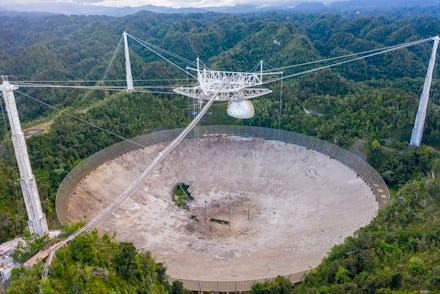The legendary Arecibo Observatory, which searched for alien life, is being demolished

The Arecibo Observatory in Puerto Rico is one of the most recognizable and important tools in humanity's search for other intelligent life in our galaxy. On Thursday, the National Science Foundation (NSF) announced that it will decommission and ultimately demolish the radio telescope following a series of cable failures that have significantly damaged the observatory. The alternative, experts warn, is risking further cable breaks that could ultimately cause the facility to collapse.
Two cables have failed over the course of the last few months, according to the NSF. Those failures have already done some damage, but it's nothing compared to what could happen if the remaining cables are asked to hold for much longer. Those cables, which run from three 300-foot tall towers, are responsible for supporting a 900-ton platform, which is suspended 450 feet directly over the Arecibo's recognizable 1,000-foot-wide dish. Should one of those cables snap, it could cause the massive platform to come crashing down, causing irreparable damage to the dish below. It's possible that another incident could also cause the towers to collapse and potentially destroy the nearby visitor's center and other buildings in the vicinity.
Salvaging the situation, sadly, is not on the table. NSF said it sought out multiple assessments, provided by independent engineering companies, to see if there was any way to support the structure and keep the observatory operational. The conclusion of basically all of those assessments was a disappointing "no." The very idea of trying to perform repairs would require putting engineering in life-threatening situations. Even if the fixes succeeded, it would likely only buy them a little more time with the telescope. NSF was told that the structure would face long-term stability issues even if the cables could be stabilized.
That leaves just one choice on the table, and it's a devastatingly sad one. The Arecibo Observatory and its 305-meter telescope will be decommissioned and eventually demolished. According to the NSF, the decommissioning process is already underway. While the organization hopes to restore parts of the facility and maintain the visitor's center, its crown jewel, the radio telescope, is "subject to a controlled disassembly."
The news is heartbreaking for the scientific community, as the Arecibo Observatory has been responsible for some of the most interesting deep space discoveries made over the last half-century. The radio telescope has helped to clarify how Mercury rotates, and eventually helped to uncover evidence of ice on the distant planet. It was used to discover the first-ever binary pulsar, which is a binary system made up of two pulsating neutron stars that orbit around the same center of mass. It also helped confirm the presence extrasolar planets, providing the first evidence of their existence. It also had frequent cameos in movies, including Golden Eye, Contact, Deep Impact, and others.
The Arecibo Observatory will perhaps be best remembered for its most ambitious mission: trying to communicate with alien life. The massive dish was tasked with the search for extraterrestrial intelligence and used to transmit coded messages that contained fundamental information about human life. It never did receive a response, but it did extend the reach of humanity to any life forms out there who might be searching for us same as we search for them.